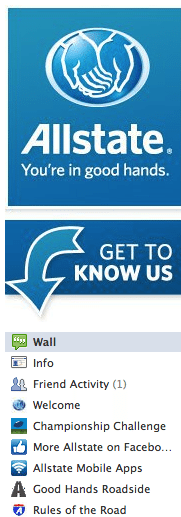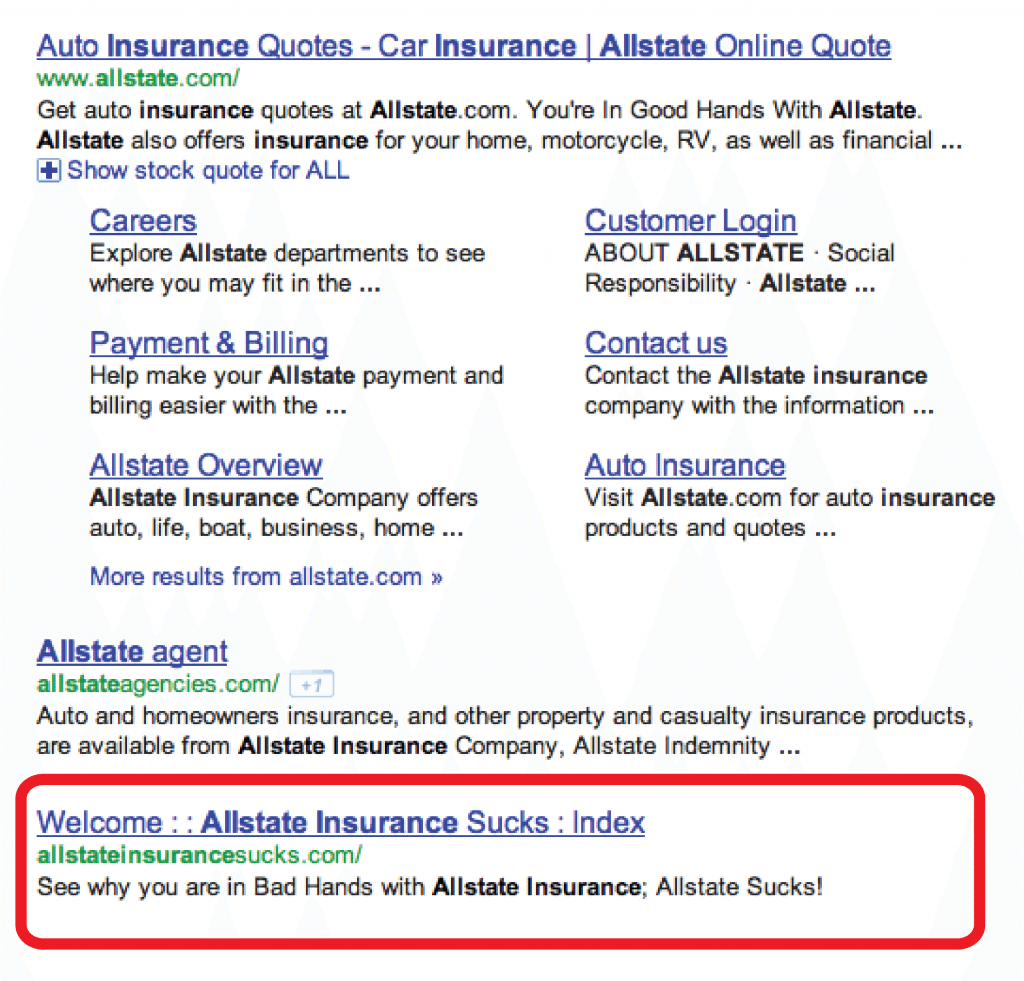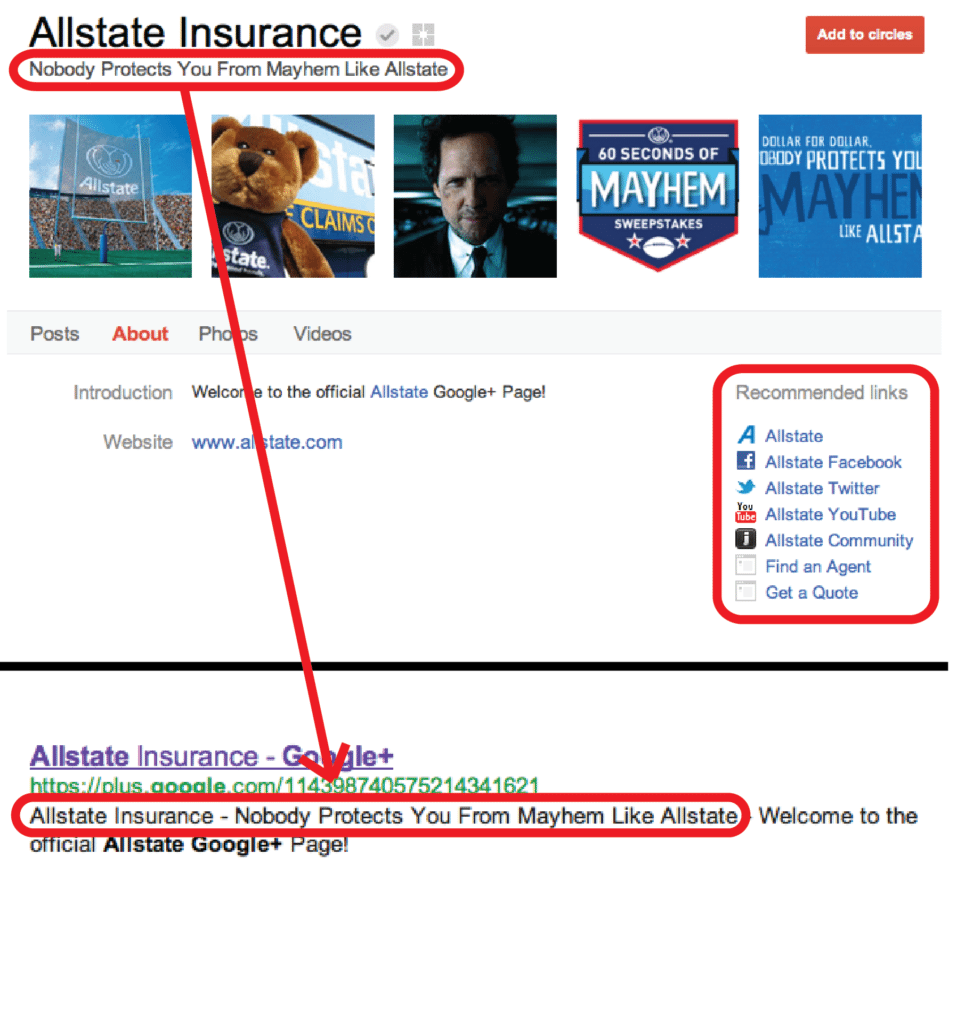Earlier this week Crain’s released its list of the top 10 most effective Chicago-based social media marketers. The study was based on Dachis group figures that look at audience strength, content sharing, conversation strength, topical alignment and sentiment.
We were happy to see that a member of the insurance industry made its way onto the list, with Allstate at number eight.
Industry aside though, we take issue with one key conclusion. Crain’s credits the company’s “Mayhem” campaign for all of its social success. And while an ad campaign can certainly lend itself to social, the real digital success is a result of strategy that uses the perks of each social platform to its advantage and cross-promotes between them while backing with digital paid media. Read on for a look at what effective digital and social media for insurance looks like.

Allstate’s Facebook page maximizes the visibility of its various applications, from those that are Facebook native to multiple mobile applications. Front and center is the Allstate Championship Challenge Facebook application, which is featured on the landing page so that new users can’t miss it.
The page menu (found in the lefthand column) features all of Allstate’s mobile apps, which is a great way to attract attention to this platform via Facebook.
General Facebook content is pleasantly diversified with talk of insurance, holidays and football among other topics. Plus, the variation of sharing formats keeps things interesting; instead of a flood of constant text, they alternate between statuses, polls and pictures.
 For large companies that rely on effective customer service, a responsive community management team is essential, especially on Twitter. Customers turn to this platform to be heard and have their insurance issues expedited to the right people. Allstate gets points for having an active team of responders. Plus, the “Meet the Team” column on the lefthand side of their Twitter page personifies the response team so that users feel like they are talking to an actual human rather than a robot. Team members then sign tweets with their initials to let people know exactly who they are talking to. Talk about an effective use of social media for insurance brands!
For large companies that rely on effective customer service, a responsive community management team is essential, especially on Twitter. Customers turn to this platform to be heard and have their insurance issues expedited to the right people. Allstate gets points for having an active team of responders. Plus, the “Meet the Team” column on the lefthand side of their Twitter page personifies the response team so that users feel like they are talking to an actual human rather than a robot. Team members then sign tweets with their initials to let people know exactly who they are talking to. Talk about an effective use of social media for insurance brands!
The company uses tweets (accompanied by a shortened link) to drive followers to its Facebook-based Championship Challenge game. This encourages likes and further engagement on a variety of platforms.
The insurance giant uses the hashtag #AllStateFanFest to draw attention to its Sugar Bowl sponsorship. This hashtag also brings all the pregame buzz together in one place that includes the Allstate name. So you’re company can’t afford to sponsor the Sugar Bowl? Not a problem. Hashtags – either those that you create or preexisting terms that are related to your industry – can unite conversation participants and get your name in front of the right people.
Allstate also wisely placed its social media links in the left sidebar so users can find them on other platforms.
YouTube
The biggest of appeal of Allstate’s YouTube channel may be the Mayhem commercials, but the platform is also full of other quality content.
In addition to Mayhem videos, Allstate provides an entire category of how-to and safety videos that relate directly to the types of insurance they sell. Need to learn how to fuel a boat? Check your oil? Change a headlight? Allstate has the answers in convenient video format on their YouTube channel.

Again, the social links at the top of this platform drive viewers to other social outlets – which is key because with 21,839,206 upload views (as of January 4th writing), there is no shortage of eyeballs on this page.
Google+
It’s true that social media is more than a number-of-followers game, but the more +1s or followers you have on Google+, the better your site will perform in search. Here’s an example. If I follow Allstate on Google+, they are more likely to pop up in organic search than someone that I do not follow. For a gigantic brand like Allstate with a huge paid search budget, this may not be the highest priority, but for smaller brands it can make a huge difference. Besides, being +1’d or added to circles 1023 times (as of January 4th writing) certainly doesn’t hurt Allstate’s organic search performance.
Speaking of +1’s, an easy way to stack them up is by adding a +1 button to your website. This element is missing from Allstate’s homepage. These “votes” show up in search results, letting searchers know what the most popular link is on their results page. Plus, Google now even shows users if anyone in their circles has +1’d your page. And if someone sees that their friends recommend one product over another, we all know which one they’re more likely to pick.
A simple line of code can directly link your company’s website and Google+ page. This determines where your Google+ profile comes up in search – and with a quick search for Allstate, we can tell that they have yet to make this connection. Had they connected the two, there’s a good chance that we’d see their Google+ profile in the number three slot instead of a link to the not-so-favorable allstateinsurancesucks.com.
 Google utilizes most of the information you provide for your G+ profile, so it’s important not to leave any gaps. The description directly below your brand name is plugged into the metadata that shows up in search results, so what you write here matters. And like on all other web platforms, it’s essential to link everything together by providing links to your website and social profiles.
Google utilizes most of the information you provide for your G+ profile, so it’s important not to leave any gaps. The description directly below your brand name is plugged into the metadata that shows up in search results, so what you write here matters. And like on all other web platforms, it’s essential to link everything together by providing links to your website and social profiles.
 Finally, we love all of those “Find Us Elsewhere” links on Allstate’s website, Facebook, Twitter and YouTube pages, but a link to Google+ is mysteriously absent on each of these pages.
Finally, we love all of those “Find Us Elsewhere” links on Allstate’s website, Facebook, Twitter and YouTube pages, but a link to Google+ is mysteriously absent on each of these pages.
Dollars for Likes
Having digital content is great – but it’s also worth noting that content is made more popular more quickly by effective use of digital paid media. By placing what are essentially ads for ads in social networks, search engine results and banners around the web, Allstate is trading cash for social popularity. And that may be paying off in a big way by extending the value of CPC.
A successful social engagement campaign is about maximizing the features of the platforms and paid search options that fit for your company. With the exception of Google+, Allstate does a thorough job of building connections with users on social media. And it is this strategy, rather than hard numbers, that puts Allstate on the list of top 10 corporate social media campaigns coming out of Chicago.